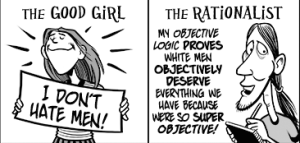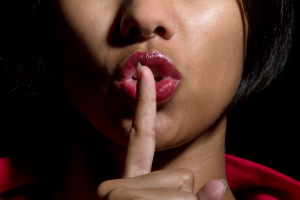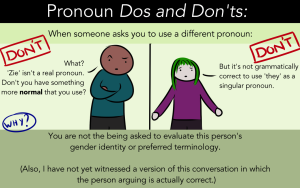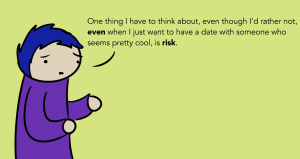
Closeup on a person looking thoughtfully into the camera, their hand touching their face.
“I don’t think I could ever date a white woman. I would be too nervous. Like when I was in retail, I hated approaching white women. I always waited for them to ask me a question. Then I would have to — you know — act differently.”
My brother paused and looked at me knowingly. We had been talking about racial fetishization, and I was really getting into the flow of the conversation. But his admission left me baffled.
“Huh?”
“You know how you have to act differently around them? I always made my voice higher, slumped a little bit, spoke softer. Usually I stood further away, especially if they were alone.”
I was quiet for a few moments, unsure of what to say. I knew from my own job experiences that workers in customer service have to be outgoing, constantly smiling, and actively talking to customers. So in what universe did his actions even make sense?
“They just always looked scared of me. I didn’t want to come off as too aggressive and lose my job or something.” He stared back at me and said, “I don’t know why you look surprised.”
We let the silence sit, and I tried to think about his question seriously. I was very aware of the violence that men, boys, and masculine-of-center people of color consistently face because they’re deemed too physically intimidating. They’re seen as brutish, savage, and dangerous. I knew that Black men are especially seen as so dangerous that they’re inhuman. As I looked at my brother, I thought of Mike Brown, and how his killer described him as a grunting, aggressive “demon.”
I looked at my brother – a short, slim, charismatic Latino, who’s often racialized as Arab – and imagined him at work. Hunching over, speaking softly, trying his hardest not to look like the scary, brown man cornering the dainty white woman.
As a Man of Color, my brother had internalized the idea that he was dangerous to white women. It is not that he wanted to harm white women, but rather that he would automatically be seen as a threat to them because of his race and gender.
The idea that Men of Color must perform in a “safe” way around white women is connected to the myth of “pure white womanhood.”
This myth directly comes from racist and sexist ideologies, and it has a few different layers.
Under patriarchy, women and gender non-conforming folks are systemically oppressed. But because of the intersections of race, class, dis/ability, sexual orientation, and other identities, not all women and gender non-conforming folks experience oppression in the same ways.
For example, while all women are objectified under patriarchy, the concept of white womanhood has a very different connotation than Black womanhood does.
In her book The Fair Sex: White Women and Racial Patriarchy in the Early American Republic, Pauline Schloesser traces some historical ideas about white womanhood. She explains that the idea of “the fair sex” directly tied white womanhood to domesticity and sexual purity.
These ideas emerge even more in the nineteenth century with the myth of the “Cult of True Womanhood.” “True Women” – which were limited to white, mainly upper class women – were expected to uphold the four virtues of piety, purity, submission, and domesticity. These “virtues” were directly tied to white women’s sexuality and ability to reproduce.
Dora Apel goes into this more in Imagery of Lynching: Black Men, White Women, and the Mob. She says, “White women where thus considered naturally superior because of the purity of their whiteness… [They are] assigned a single, undivided nature; she is a vessel for reproduction who remains somehow untouched by sexual drives.”
Because white women’s value was directly tied to their purity, it became the duty of white men to make sure they were pristine. White women were seen as objects whose only duty is was to continue the white race.
This myth was especially antiblack, and was used to demonize white woman/black man relationships in the 1900s. In Race Mixing: Black-White Marriage in Postwar America, Renee Romano talks about how this idea supported anti-miscegenation laws and fear of interracial relationships. She explains, “Whiteness was easily corruptible and blackness was all-consuming… The survival of the white race depended upon its women, who were designated as the guardians of white racial purity.”
These myths of “pure” white womanhood are obviously extremely harmful for white women. It creates a misogynistic where white women have very little agency, particularly sexually.
However, this myth also negatively – and deeply – affects Men of Color.
Men of Color, especially Black men, have historically been coded as animalistic abusers and rapists when it comes to white women. This stems from the idea that Men of Color literally want to steal and sully the belongings of white men.
In turn, it becomes the “duty” of white men to protect white women – not because they truly care about white women, but because white women are the property of white men.
A number of racist, cissexist stereotypes about Men of Color have emerged in contrast to “protecting” and “defending” white womanhood. These stereotypes, which are racialized and gendered biases against Men of Color, have led to emotional, mental, and physical violence.
As Sally Kitch explains in her book The Specter of Sex: Gendered Foundations of Racial Formation in the United States, “[V]iolence against men of color usually entailed explicit or implicit suspicious of sexual aggression, perversion, or intention; and implications that all competition between men of color and white men – over land or horses or sex – somehow threatened white manhood and white women’s virtue.”
Although the idea of white women needing “protecting” might sound old-fashioned, these ideas haven’t been left in the past.
While all of these stereotypes have historical starting points that are very important, these ideas have continued on in the present. These stereotypes about Men of Color are ever growing and have continued a vicious cycle: Men of Color have literally been killed for white women.
I want to make it clear that this is not about playing “Oppression Olympics.”
I’m not saying that Men of Color necessarily suffer more than white women under patriarchy. This also isn’t to say that Men of Color don’t rape or assault women.
This is about creating a more nuanced understanding of how oppression is very much horizontal.
We know that patriarchy creates a system of toxic masculinity that negatively affects people of all genders, and is an extremely harmful system for boys and men.
But when we look at how patriarchy creates a system of privilege and oppression, it can also be very easy to say, “all men benefit from patriarchy, and everyone else suffers under it.” Often, we don’t make nuanced connections about how one aspect of it can affect two seemingly very different communities.
While white women really have no say under patriarchy, it’s also important for us all to recognize how we can both be marginalized by a system and be complicit in it. White men haven’t been the only ones who perpetuate these stereotypes and harm Men of Color.
Historically, white women have been both proactive and apathetic to the violence that Men of Color face in their name. I know that I have personally heard a wealth of stories about white women crossing the street, clutching their purses, and locking their car doors when a Black or Brown man passes by.
We all need to confront these stereotypes because they cause harm on multiple levels. It’s not only about giving examples, but also understanding how these show up in our everyday lives. Men of Color like my brother deserve so much more than to be reduced to these myths. They deserve so much more than to look at themselves though these violent lenses.
Just a few of the stereotypes perpetuated to “protect” white womanhood are below:
1. The ‘Black Brute’
One of the most long-lasting stereotypes that’s been used to harm Black men is the myth of the “Black Brute.”
Most of the earliest references to this stereotype were created during the late 1800s. In Manliness and Civilization: A Cultural History of Gender and Race in the United States, 1880 – 1917, Gail Bederman explains that this stereotype was used to categorize Black men as inherently violent, uninhibited, and hypersexual. This stereotype, which is very similar to the Black Jezebel trope, was used to dehumanize Black men.
The “Black Brute” stereotype was mainly used as an explanation for why Black people needed to be kept enslaved – namely through perpetuating the idea that that Black men uncontrollably preyed on white women. White men saw themselves as the main line of defense to protect white womanhood and societal power.
As bell hooks explains in We Real Cool: Black Men and Masculinity, “[T]he black male body continues to be perceived as an embodiment of bestial, violent, penis-as-weapon, hypermasculine assertion.”
During Reconstruction and Integration, this stereotype became even more widespread: The myth of the “Black Brute” was often used as a catalyst for lynching and killing Black men throughout the United States.
Ida B. Wells-Barnett’s work, especially The Red Record, highlights that this stereotype was used to perpetuate mass killings. Emmett Till – a young Black boy who allegedly whistled at a white woman and then was savagely beaten and killed – is one of the most famous examples of this common occurrence.
Unfortunately, the stereotype of the “Black Brute” persists today in the media and in everyday occurrences. And this stereotype has also contributed to physical violence as well.
It was just one year ago that nine Black people were shot and murdered in a Charleston church. The killer explicitly stated that he killed them because “You rape our women, and you’re taking over our country, and you have to go.”
Although this stereotype is over 100 years old, it is still being used today to defend white womanhood. Black men are still seen as animalistic things that are incapable of anything but violence – and thus need to be killed because of it.
2. The ‘Yellow Peril’
Today, East Asian men are mainly stereotyped as effeminate, thus supposedly making them terrible sexual and romantic partners. While this stereotype has a long history in the United States, it’s not the only sexual stereotype that’s been used against East Asian men.
The stereotype of “Yellow Peril” emerged in two different time periods.
First, it was used against mainly Chinese men in the 1800s. It was used again mainly against Japanese folks during World War II.
During these times, East Asian men were coded as predatory foreigners whose main goals were to colonize Western Europe and the United States. And part of this fear of colonization included threats to white womanhood. White patriarchy perpetuated the idea that East Asian men would systematically rape and kill white women if they had a chance.
The “Yellow Peril” stereotype relied on the idea that East Asian sexuality was inherently violent. East Asian men were stereotyped as cunning men with insatiable desires. In Asian American Dreams: The Emergence of an American People, Helen Zia quotes 1800s orator Horace Greely, who summed up these stereotypes by saying, “The Chinese are uncivilized, unclean, and filthy… lustful and sensual in their dispositions.”
Propaganda was widespread to perpetuate these stereotypes. Chinese men were portrayed as men who strategically stole white men’s jobs and tricked white women; Japanese men were portrayed as warmongers and rapists.
One major example was the widespread tabloid articles in the late 1800s. They suggested that Chinese men were using opium to seduce and rape white women at alarming rates: Newspapers like The Hearst were “periodically frantic about an oncoming ‘Yellow Peril,’ with the Tong Wars in Chinatown as proof that Chinese were bloodthirsty, sneaky, and… lustful for white women.”
Another example is the actor Sessue Hayakwawa, a famous Japanese-American actor from the 1900s. Sessue was often fetishized and acted in roles where his sexuality was a threat to white female characters. His characters were often the epitome of the “Yellow Peril.”
This is important because as one of the only East Asian stars at the time, this was the kind of representation mainstream America had of East Asians. They perpetuated idea that East Asian men were all villainous and predatory. This urged on the violent stereotypes that white women needed protection from East Asian men.
3. The ‘Muslim Predator’
In the media, Middle Eastern and North African (MENA) people are often categorized as Muslim and Arab, whether or not folks claim either or both of those identities. MENA folks are homogenized, racialized, and treated interchangeably with no regard to the different peoples, cultures, and languages of these two regions.
In Race and Arab Americans Before and After 9/11: From Invisible Citizens to Visible Subjects, Nadine Naber explains that the media has “increasingly portrayed persons associated with the category ‘Arab/Middle Eastern/Muslim’ as not only culturally backward, uncivilized, exotic, or potentially dangerous, but also as potential enemies of the U.S.”
A recurring stereotype that is often used against Middle Eastern and North African men is the idea of the “Muslim Predator.” This stereotype claims that Muslim men want to destroy Western civilization, and that in their quest to do so, they will rape and kidnap white women.
The trope of the “Muslim Predator” can be found in many different media time periods, but was especially prominent in the early 1900s and again in the 1980s, due to colonization and war.
Lauren Michalak explains, “These 1920s films about the Middle East fall into two main groups. Most are exotic adventure melodramas set in the desert. In these, Arabs are associated with violence and sexuality – abducting white women or sweeping in hordes out of the desert to attack the Foreign Legion outpost.”
Because of white patriarchy, there is a fear that MENA men will take over the Western world and treat white women just as “savagely” as they treat MENA women. Regardless of the level of misogynistic violence happening in the United States, Non-Western people are categorized as uncivilized and dangerously sexist. MENA women need to be “saved.”
It’s not that white men particularly care about MENA women, it’s that they are scared that these MENA men will treat white women – the property of white men – just as violently.
Since September 11th, there has been an increase of this stereotype used in the news. Many conservative sources, for example, suggest that MENA refugees shouldn’t be allowed to enter the United States or European countries. These men are treated not only as potential terrorists, but also as rapists.
Again, we have a stereotype that is specifically racialized to cause violence. In this case, white women are used as the excuse to not only physically harm folks, but to create discriminatory laws.
4. The ‘Hispanic Criminal’
The stereotype of the “Hispanic Criminal” isn’t something that Donald Trump just made up, although it has certainly gained popularity due to him.
The idea that Latinos – specifically Mexican, Central, and South American men – are criminals and rapists has been perpetuated for a long time.
A major sexual stereotype about Latinos is that they’re suave lovers who can seduce anyone, especially white women. Another aspect of this stereotype is that Latinos specifically target white women in order to corrupt them. The trope goes that Latino criminals, usually drug dealers, kill white men and steal their women and money.
An important historical moment in the perpetuation of this stereotype emerged when weed was made illegal. During the 1930s, the Drug Enforcement Administration began to use racist propaganda. They said that most weed users were Black and Chicano men who would rape and murder their white neighbors.
Unfortunately, with growing rates of racism and xenophobia, this stereotype has only gained traction, even amongst “liberal” white women such as Amy Schumer. Media isn’t consumed in a vacuum. Racist jokes aren’t just tasteless; they perpetuate harmful ideas. Perpetuating violent stereotypes, even as jokes, simply normalizes them.
It not only makes it seem okay for everyone to “joke around” about racialized rape, but it also makes it difficult to have real, intra-community conversations about sexual assault.
When violent stereotypes are perpetuated about a community, these are the only characteristics attributed to folks. That makes it very easy to have a gut-reaction of “that never happens!” in order to dispel these stereotypes. When that happens, it can be very impossible for survivors of assault to speak their truth.
These stereotypes not only perpetuate violence against Latinos, but against all Latinxs.
***
These stereotypes are important to reflect on because intersectionality is important!
These stereotypes have not only been used in the past to perpetuate violence against Men of Color. They’re ever-present factors in how Black and Brown men navigate the world. The violence they face and their fears are very real.
It’s just like Audre Lorde said in Sister Outsider: “Some problems we share as women, some we do not. You fear your children will grow up to join the patriarchy and testify against you; we fear our children will be dragged from a car and shot down in the street, and you will turn your backs on the reasons they are dying.”
This is so important because it’s vital for us all to reflect on the ways that a system can oppress us, use us against others, and give us power.
It’s not only white men who perpetuate these stereotypes. These are ideas that we all internalize. My brother, and other Men of Color, shouldn’t have to make themselves smaller to “protect” you or themselves.
If you are a white woman, you need to analyze your complacency and your active participation in the violence done to Men of Color. This isn’t about guilt or placing blame. It’s about working in a nuanced way to dismantle an oppressive system that negatively affects us all.
[do_widget id=’text-101′]
Jennifer Loubriel is a Contributing Writer for Everyday Feminism and a mixed race Afro-Puerto Rican from the Bronx. She is also a queer mujerista and child abuse survivor. She earned her B.A. from Oberlin College in Religion and English, and identifies as an amateur Latinx ethicist and a speculative fiction enthusiast. She is a co-founder and moderator over at the Tumblr Women of Color, in Solidarity, a safe space for and by women of color. You can usually find her writing about apocalypse and diaspora, rewatching her favorite TV shows, or taking selfies with her family’s cat.
Search our 3000+ articles!
Read our articles about:
Our online racial justice training
Used by hundreds of universities, non-profits, and businesses.
Click to learn more




















